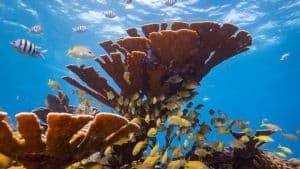A biological community of organisms and their environment is called an ecosystem.

All of the organisms in an ecosystem are dependent on biotic as well as abiotic factors for energy and nutrition.
Interdependence in nature is illustrated by the transfer of energy within an ecosystem.
There are two major types of ecosystems:
- Terrestrial ecosystems
- Aquatic ecosystems
Terrestrial ecosystems are further distributed into:
- Forest Ecosystem
- Grassland Ecosystem
- Tundra Ecosystem
- Desert Ecosystem
Aquatic ecosystems are divided into:
- Freshwater Ecosystem
- Marine Ecosystem
Table of Contents
A biological community and its associated physical environment comprise
A biological community and its associated physical environment comprise an ecosystem.
In biology, the term “species” refers to all organisms of the same kind that are potentially capable, under natural conditions, of breeding and producing fertile offspring.
A group of organisms of the same species that live in an area at the same time constitute a population.
All the populations living and interacting within a particular geographic area make up a biological (or biotic) community, and their relationship is called an ecological relationship.
A community and its physical environment
A community and its physical environment is an ecosystem. An ecosystem is basically the region in which populations interact with each other and with the abiotic factors.

The physical environment is comprised of abiotic factors. Abiotic factors or abiotic components, are physical parts and non-living chemicals of an environment.
They affect the functionalities and living organisms of the ecosystems. Abiotic components and the phenomena related to these factors underpin biology as a whole.
Abiotic factors include non-living resources and physical conditions that impact living components in terms of reproduction, maintenance, and growth.
Resources are differentiated as objects and substances in an environment needed by a single organism and exhausted or otherwise turned unavailable to use by various other organisms.
Component deterioration of a substance occurs by physical or chemical processes such as hydrolysis.
Every non-living component of the ecosystem, like water resources and atmospheric conditions, are known as ‘Abiotic components’.
A system of living organisms a barrier
A system of living organisms a barrier is a coral reef.
A coral reef is an underwater ecosystem characterized by reef-building corals. Reefs are formed of colonies of coral polyps held together by calcium carbonate.

Most coral reefs are built from stony corals, whose polyps cluster in groups.
Coral reefs are important ocean habitats and offer a compelling case of the risks of climate change.
Reefs provide a large fraction of Earth’s biodiversity—they have been called “the rain forests of the seas.” Scientists estimate that 25 percent of all marine species live in and around coral reefs, making them one of the world’s most diverse habitats.
Communities and the abiotic material with which their members interact
Communities and the abiotic material with which their members interact is an ecosystem.
The variety of organisms that inhabit the earth and interact within an ecosystem form a community. A community consists of a population of multiple different species or a population of living things.
Communities of plants, animals, and microorganisms are called
Communities of plants, animals, and microorganisms are called an ecosystem.

Organisms most likely to belong to the same species comprise a population.
A community differs from a population in that a community:
- is larger than a population.
- is more diverse than a population.
- gene flow can occur, but only interbreeding can take place within a population.
- has a dissimilar structure.
- has organisms that behave differently.
- has a predator-prey relationship.
FAQ
What is a community of interacting organisms and their environment called?
A community of interacting organisms and their environment is called an ecosystem.
Communities consist of all the different populations within the ecosystem.
Communities evolve to have greater biomass and species richness in a process called succession.
Some of the major characteristics of a community ecology are as follows:
- Species Diversity
- Growth From and structure
- Dominance
- Self-reliance
- Relative abundance
- Trophic structure
Which term may be defined as the specific physical location of a community?
The term defined as the specific physical location of a community is a habitat.
There are mainly six different types of habitats:
Forests
Aquatic habitat
Deserts
Grasslands
Mountains
Polar habitats